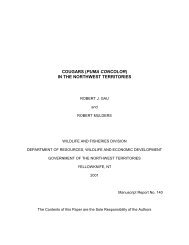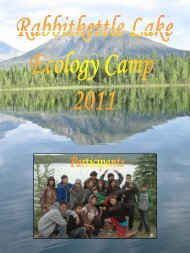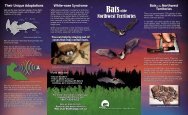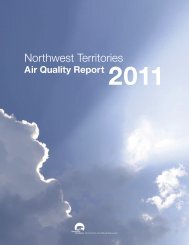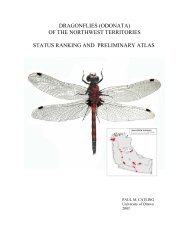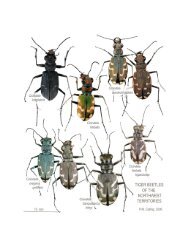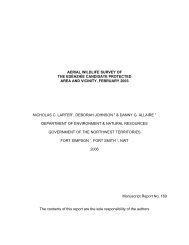Sandy Creek Ecology Camp 2012 - Environment and Natural ...
Sandy Creek Ecology Camp 2012 - Environment and Natural ...
Sandy Creek Ecology Camp 2012 - Environment and Natural ...
Create successful ePaper yourself
Turn your PDF publications into a flip-book with our unique Google optimized e-Paper software.
Axell Bouvier<br />
Age:14<br />
Fort Providence<br />
Nathaniel Minoza<br />
Age:15<br />
Fort Providence<br />
William Alger<br />
Age:14<br />
Fort Simpson Keagan Nadli<br />
Age:15<br />
Fort Providence<br />
Kody Hardisty<br />
Age:14<br />
Jean Marie River<br />
Nathaniel Tsetso<br />
Age:12<br />
Morgan Elleze Fort Simpson<br />
Age:14<br />
Fort Providence
Michelle Lafferty<br />
Age:13<br />
Fort Simpson<br />
Rochelle Yendo<br />
Age:13<br />
Wrigley<br />
Natasha Nadli<br />
Age:15<br />
Fort Providence<br />
Sk Sky LLennie i SSasha h Squirrel S i l<br />
Age:12<br />
Fort Simpson<br />
Age:15<br />
Fort Providence
Sharon Pekok<br />
Supervisor<br />
KFN<br />
Fred Tambour<br />
Elder<br />
KFN<br />
Bruce Townsend<br />
Instructor<br />
AAROM<br />
Alexa Tsetso<br />
Instructor<br />
Recreation<br />
Ron Antoine<br />
Instructor<br />
ENR<br />
Pat Martel<br />
Elder<br />
KFN<br />
Clara Lafferty<br />
Elder<br />
KFN<br />
George Low<br />
Instructor<br />
AAROM
Cathy McArthur<br />
Assistant Cook<br />
KFN<br />
James Hatch<br />
Teacher<br />
Fort Providence<br />
Michelle Lafleur<br />
Instructor<br />
KFN<br />
Georgina Fabian<br />
Instructor<br />
KFN<br />
Mike Low<br />
Instructor<br />
AAROM<br />
Violet Fabian<br />
Cook<br />
KFN<br />
Stephanie Yuill<br />
Instructor<br />
ENR
After the students unloaded their gear <strong>and</strong> met everyone, they were<br />
given an orientation off the camp, provided with the camp rules, <strong>and</strong><br />
assigned their accommodations. Students went for a supervised swim<br />
afterwards.<br />
<strong>S<strong>and</strong>y</strong> <strong>Creek</strong> cooking area<br />
<strong>S<strong>and</strong>y</strong> <strong>Creek</strong> cooking area<br />
<strong>and</strong> gathering place.<br />
Start of <strong>S<strong>and</strong>y</strong> <strong>Creek</strong> road to<br />
camp.
Chief Roy Fabian <strong>and</strong> Councilor Robert Lamalice welcomed the youth<br />
to the camp, they explained <strong>and</strong> showed the youth how to do a Fire<br />
Feeding ceremony <strong>and</strong> a Blessing of Water ceremony. The<br />
importance of paying respect to the l<strong>and</strong> was explained to the youth,<br />
a practice that is still used to this day by traditional harvesters harvesters.<br />
Chief Roy y Fabian<br />
warming up his drum<br />
to sing a prayer song.<br />
Youth gathered in<br />
a circle waiting<br />
for Roy to start<br />
the prayer song.
Staff <strong>and</strong> students went to Hay River to go to the swimming<br />
pool to learn how to snorkel. The weather wasn’t ideal for<br />
outside activities so it was decided to go to the swimming<br />
pool earlier than planned. The kids thorough enjoyed going<br />
to the pool pool.<br />
St d t ti i<br />
Students practicing<br />
snorkeling at the Hay<br />
River Pool.<br />
Students enjoying the<br />
Hay River Pool.
Ron Antoine, a Renewable Resource Officer with <strong>Environment</strong><br />
<strong>and</strong> <strong>Natural</strong> Resources (ENR) taught the students about bear<br />
safety. He taught the students how to properly store food while<br />
out on the l<strong>and</strong> away from sleeping quarters, <strong>and</strong> many other<br />
helpful bear safety tips were reviewed reviewed. Many different types of<br />
bear deterrents were shown to the youth <strong>and</strong> Ron showed<br />
photos of camps near Hay River that had bear problems in the<br />
past.<br />
Ron explaining to the<br />
students the different<br />
bear deterrents that<br />
are available to ENR<br />
officers.<br />
Ron explaining to the<br />
students how to lessen<br />
bear problems out on<br />
the l<strong>and</strong> by keeping a<br />
clean camp, storing<br />
food separately from<br />
sleeping area etc.
During the course of the camp camp, Bruce taught modules on water<br />
ecology to the students. Freshwater zooplankton, the water cycle,<br />
dissecting fish, contaminants, biomagnification <strong>and</strong> food web<br />
dynamics were some of topics taught to the students. Students went<br />
out on field trips <strong>and</strong> used scientific equipment to do experiments.<br />
Th The zooplankton l kt were viewed i d under d amicroscope i bby th the students. t d t<br />
Mike taught fish biology <strong>and</strong> anatomy to the youth while Clara<br />
demonstrated how to prepare fish for cooking.<br />
Bruce taught the students how to<br />
use the Secchi disk to tell how<br />
transparent the water is.<br />
Students learned how water foodweb<br />
dynamics worked.<br />
George demonstrating to the youth<br />
how to use a Secchi disk disk.<br />
Students used marshmallows to<br />
build molecules.
Bruce getting a specimen ready Students using a Plankton Net in<br />
to look under the microscope<br />
microscope. the creek to catch aquatic life life.<br />
Students trying to catch small<br />
fish using the Seine Net.<br />
A student looking at the different<br />
microorganisms caught with the<br />
Plankton Net.<br />
Keying out what insects were<br />
caught in the Plankton Net.<br />
A student looking at a specimen<br />
under a microscope.
Bruce, George, Mike, Michelle <strong>and</strong> Alexa taught the students<br />
water, boat <strong>and</strong> canoe safety. The students learned the<br />
importance of wearing a lifejacket while in a boat <strong>and</strong> to have<br />
supplies onboard like a paddle, fire extinguisher, throwbag <strong>and</strong><br />
a bailer. All activities were taught <strong>and</strong> practiced on dry l<strong>and</strong>. The<br />
students took turns rescuing each another with canoes. It was<br />
quite a popular event for the students who wholeheartedly<br />
participated in the exercise.<br />
Students practicing paddling in a<br />
canoe.<br />
Mike taking the youth to set a fish<br />
net.<br />
Students coming g back from Students going g g back to camp. p<br />
checking the fish net.
All staff <strong>and</strong> students had to wear life jackets during trips on<br />
the lake <strong>and</strong> creek <strong>and</strong> students had to be supervised while<br />
doing water ecology activities on the lake. Each student was<br />
fitted with a lifejacket according to their weight <strong>and</strong> size. The<br />
weather was great for the majority of the camp camp, all water<br />
related activities were the highlights for a lot of students.<br />
Students going for a boat ride to<br />
False Point with elder Pat Martel.<br />
Students returning from their trip<br />
on Great Slave Lake.<br />
George supervising the youth<br />
driving the boat.<br />
George setting a Gill net to<br />
catch small fish with the youth.
Traditional knowledge was taught by Clara Clara, Fred Fred, Georgina Georgina,<br />
Pat, Roy <strong>and</strong> Robert. Clara <strong>and</strong> Fred showed the students how<br />
to prepare fish for cooking. Fred, Roy, Robert, <strong>and</strong> Pat told<br />
traditional stories <strong>and</strong> shared some of the history of the area<br />
with the students. The instructors taught the students how to<br />
feed the fire <strong>and</strong> water. The students found it quite interesting<br />
<strong>and</strong> participated every step of the way.<br />
Whitefish getting<br />
cooked on open fire.<br />
Students demonstrating how to<br />
play dene h<strong>and</strong> games.<br />
Fred preparing a fish he caught<br />
in a net.<br />
Clara showing the youth<br />
some of her beadwork.
Elder Georgina Fabian taught how to identify medicinal plants of<br />
the boreal forest during a hike near <strong>S<strong>and</strong>y</strong> <strong>Creek</strong>. Georgina<br />
showed the students medicinal plants that were used to cure<br />
ailments before hospitals were in the north. The students picked<br />
spruce sp uce gum, gu , rosehips ose ps <strong>and</strong> a d high g bush bus cranberries c a be es that t at are aeused used<br />
in traditional medicines. The students found it quite interesting<br />
<strong>and</strong> eagerly participated in looking for medicinal plants.<br />
Georgina helping a student collect<br />
spruce gum.<br />
Students listening to Georgina<br />
explain the importance of medicinal<br />
plants to the Dene.<br />
Georgina g showing g the students<br />
some important medicinal plants.
Stephanie Yuill taught the youth Species at Risk <strong>and</strong> Bat<br />
ecology in the NWT. The students enjoyed the practical<br />
exercises <strong>and</strong> participated wholeheartedly.<br />
.<br />
Stephanie taught the youth about bats in the NWT, got<br />
them to put baby powder on their nose to demonstrate<br />
White-nose syndrome that is greatly affecting North<br />
American bat populations.
Students gathered firewood with instructors <strong>and</strong> made a signal<br />
fire on the southern shore of Great Slave Lake. The students<br />
helped gather firewood <strong>and</strong> sat around the fire listening to<br />
stories from the elders.<br />
Sharon <strong>and</strong> Clara sitting by the fire.<br />
Students drying off<br />
by the fire.<br />
Fire burning on shoreline. shoreline<br />
James helping the gather firewood.
During their spare time students spent time swimming swimming,<br />
listening <strong>and</strong> socializing. They were supervised during<br />
swimming <strong>and</strong> other water activities. Evening activities<br />
included elder story telling, card games, <strong>and</strong> snacks. There<br />
were residents that regularly came during the camp to visit.<br />
The students thoroughly enjoyed their free time <strong>and</strong> got to<br />
know each other quite well.<br />
Students getting ready to go<br />
swimming.<br />
Students sat around the fire during<br />
breaks <strong>and</strong> evenings evenings.<br />
Students going for a supervised<br />
swim in Great Slave Lake.
This year there was a community feast to end the camp. The<br />
elders, supervisors <strong>and</strong> facilitators played an key role in the<br />
ecology camp’s success as did the group of students from<br />
throughout the Dehcho. All students wholeheartedly participated<br />
in <strong>and</strong> became involved with all of the different experiences<br />
provided to them during the camp camp. The students thoroughly<br />
enjoyed themselves at the <strong>2012</strong> camp <strong>and</strong> made friendships that<br />
will last a lifetime.<br />
Sunset on shoreline of<br />
Great Slave Lake.<br />
S<strong>S<strong>and</strong>y</strong> d C<strong>Creek</strong>. k<br />
Mouth of <strong>S<strong>and</strong>y</strong> <strong>Creek</strong>. <strong>S<strong>and</strong>y</strong> <strong>Creek</strong> cabins.
During the last regional wildlife workshop held in October 2010, there was<br />
consensus that the youth ecology camp should continue to be held at different<br />
locations throughout the Dehcho Region. The 2003 <strong>and</strong> 2004 camps had been held<br />
att th the TTroutt LLake k Fi Fire BBase. BBy hholding ldi th the campin i diff differentt llocations ti thi this would ld<br />
allow different communities the opportunity of hosting <strong>and</strong> conducting the youth<br />
ecology camp as well as providing the chance for participants to experience<br />
different areas of the Dehcho. A joint DFN/ENR committee reviews the proposals<br />
<strong>and</strong> awards the camp. The 2005 camp was held near Jean Marie River <strong>and</strong> hosted<br />
by L<strong>and</strong> is Life. The 2006 camp was held near Hay River Reserve <strong>and</strong> was hosted<br />
by the Katlodeeche First Nation. The 2007 <strong>and</strong> 2009 camps was held at Cli Lake<br />
west of Fort Simpson <strong>and</strong> were hosted by North Nahanni <strong>Natural</strong>ist Lodge Ltd. The<br />
2008 camp was held at Paradise creek near Trout Lake <strong>and</strong> was hosted by the<br />
Sambaa K’e Development Corporation. The 2010 camp was held at Ekali Lake <strong>and</strong><br />
hosted by the Jean Marie River First Nation. The 2011 camp was held at<br />
Rabbitkettle Lake <strong>and</strong> hosted by Nahanni Butte Dene B<strong>and</strong>/ Parks Canada. This<br />
year’s camp was held near Hay River Reserve <strong>and</strong> was hosted by the<br />
Katlodeechee First Nation. We would like to thank AAROM <strong>and</strong> Species at Risk for<br />
providing additional funding <strong>and</strong> expertise for the camp this year, without their help<br />
we would have been unable to hold a camp this year.<br />
Previous camps taught a variety of traditional <strong>and</strong> scientific skills This year’s camp<br />
Previous camps taught a variety of traditional <strong>and</strong> scientific skills. This year s camp<br />
had a great mixture of both. Students learned a lot of new tools which should help<br />
them in future endeavours. Once again we appreciate all the work the instructors<br />
<strong>and</strong> elders did this year to ensure a most memorable experience for all those who<br />
attended.




